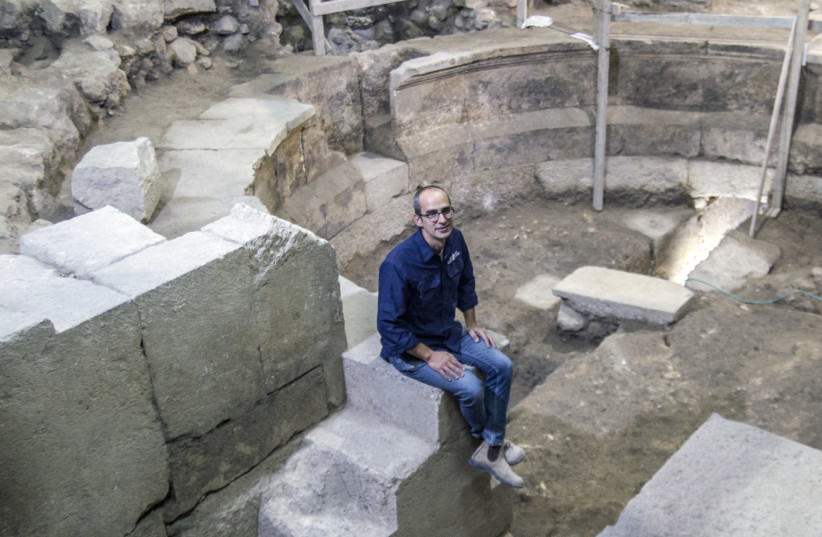by Rossella Tercatin
The research also led to the discovery of a previously unknown theater-like structure.

Dr. Joe Uziel of the Israel Antiquities Authority
sits on the steps of the theater-shaped building uncovered in the area
of Wilson's Arch by the Western Wall. (photo credit: YANIV BERMAN/IAA)
The finding is part of the results of a project carried out in cooperation by the Israel Antiquities Authority, the Weizmann Institute of Science and the Tel Aviv University which were published in the journal PLOS ONE on Wednesday.
The research also led to the discovery of a previously unknown theater-like structure in the area, offering a new extraordinary glimpse into the history of Jerusalem.
As explained to The Jerusalem Post by IAA archaeologist Dr. Joe Uziel, in the past radio-carbon dating has been used only very sporadically in the city and this new initiative aims at dramatically changing the situation in order to “set the clock of remains in ancient Jerusalem.”
For this purpose, the researchers have also pioneered new methodologies identifying organic material in the mortar between the stones to allow the analysis.
Located inside the complex of the Western Wall tunnels, Wilson’s Arch is the last prior to entering the Temple Mount and is named after the British explorer Charles Wilson, who documented it in the second half of the 18th century.
The issue of its dating had been debated by scholars for decades, with some believing the arch was indeed built during the Second Temple period while others argued it was only erected around the 7th century in the early Islamic period.
“We wanted to understand which opinion was right,” Uziel said.
Directed by Uziel, as well as IAA archaeologists Tehillah Liberman and Dr. Avi Solomon, the excavations began in 2015, in cooperation with the Western Wall Foundation.
The archaeologists worked on exposing the pier of the arch, that is the wall that holds it up.
Uziel explained that the goal was to reach some form of floor, road or pavement: assessing when the support was built would have helped to date the arch itself. However, a different surprise was awaiting.
“Instead of identifying the floor, we came across an incredible building, a theater-like structure which we believed was built after the arch, dismantling the original pavement,” he pointed out.
The team therefore needed to find a different method to reach a dating.
“This is where the cooperation with the Weizmann Institute began,” he said.
The researchers from the Weizmann’s Scientific Archaeology Unit have been focusing on what is known as “micro-archaeology.”
“For this project we had to develop a very specific strategy, starting by being in the excavation, itself,” Prof. Elisabetta Boaretto, who worked on the study together with Dr. Johanna Regev, explained in a release.
Their team was able to identify charred ancient seeds in the mortar between the stones, determine that that mortar was part of the original structure and not a later addition and analyze the material and the plaster in the D-REAMS (Dangoor Research Accelerator Mass Spectrometer) lab, coming up with very accurate dating.
Uziel told the Post the arch still standing today was built in two phases.
During the early Roman period, specifically under King Herod, the structure supported a bridge leading to the Temple Mount that was 7.5 meters wide. Herod, who ruled over Judah in the second half of the 1st century BCE, was known for his construction activity, including the renovations of the Jerusalem Temple.
A few decades later, the bridge was expanded to a width of 15 meters.
Also, the theater-like structure was determined to have been built at a very significant time in the history of Jerusalem.
“After Jerusalem was destroyed in 70 CE, the Romans left behind a legion to keep things quiet. Slowly the city began to develop as a settlement again and roughly around 130 was declared a Roman colony while its name was changed in Elia Capitolina. We can date the structure to roughly the same time,” Uziel said.
“The interesting thing is that we have several indications that the theater was never completed,” he added. “It is difficult to say whether it was because of the outbreak of the Bar Kochba Revolt or for a different reason, for example because the money ran out.”
“The Wilson’s Arch riddle could not have been solved without the use of micro-archaeology,” concluded Boaretto. “We showed that the extreme accuracy of our lab results, even for the tiniest of samples, can resolve these issues with a high degree of certainty, and we think they might help solve other archaeological puzzles for which radiocarbon dating had not previously been considered to be sufficiently precise.”
Indeed, the project of dating structures around the city continues. Among others, the team is working on remains in several excavations in the City of David, Uziel told the Post.
The excavations in the area of Wilson’s Arch are ongoing but the idea is to eventually open it up to the public, as part of the Western Wall Tunnel tour.
Rossella Tercatin
Source: https://www.jpost.com/israel-news/western-wall-arch-dates-back-2000-years-used-to-enter-temple-study-630207
Follow Middle East and Terrorism on Twitter
No comments:
Post a Comment